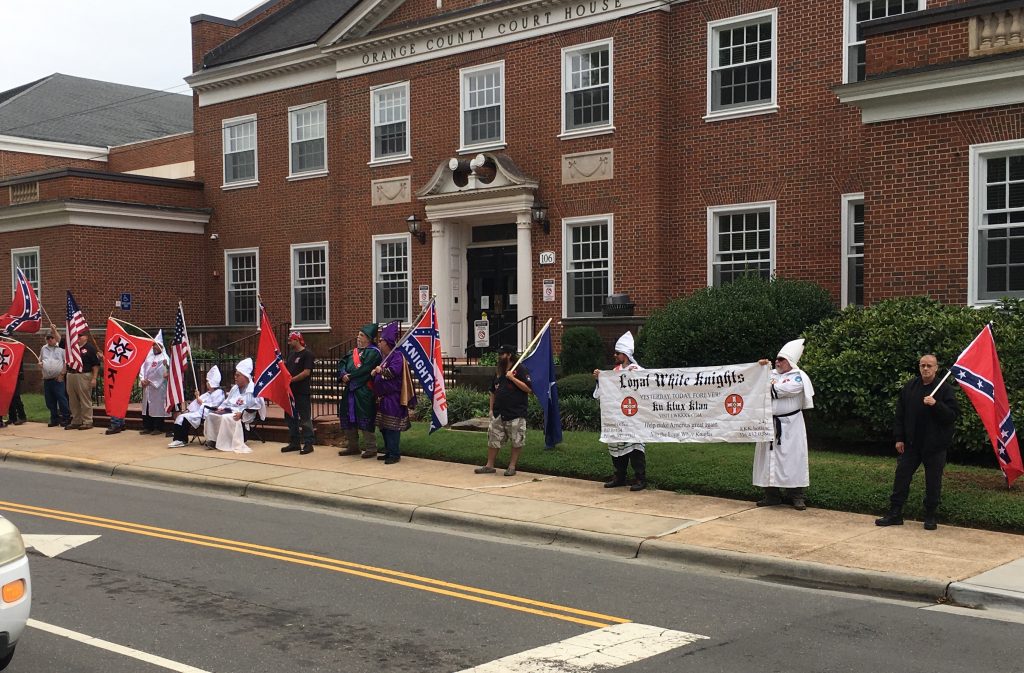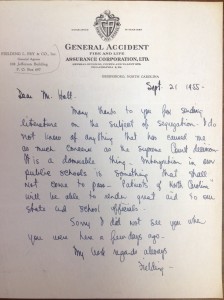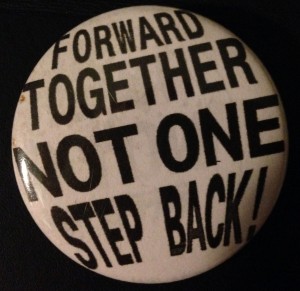Adopted from a late-night Facebook post from Aug. 24, 2019

Representatives of the Pelham Ku Klux Klan in front of the Orange County Courthouse in HIllsborough, NC
As was widely reported, a group of about 15 members of the so-called “Loyal White Knights of the Ku Klux Klan” descended on Hillsborough on the late afternoon of Saturday, August 24. Uninvited and unannounced, they drove from Pelham, NC, an unincorporated corner of northwestern Caswell County (not far from Danville, VA). Pelham is named for for Confederate Col. John Pelham, an artillery officer who fought in the Army of Northern Virginia. So that there would be no confusion as to their political affiliation, this branch of the Klan proclaims on their banner that they want to “Help make America great again.”
I saw them while on my way to Weaver Street Market and did a a double take. I first thought that it was just those same old Confederate flag-wavers at it again. We have had a regular assembly of about 4 battle flaggers over the last year. Those particular flag bearers proclaim on Orange County Local (a Facebook group moderated and dominated by local right wing activists of various stripes) that they gather in Hillsborough to pay respects to their dead Confederate ancestors and that the battle flag of the Army of Northern Virginia is by no means a racist symbol. They’ve been in a tizzy lately following a tongue-in-cheek sidewalk sign by a local chocolatier who offered free chocolate for anyone who burned a Confederate flag. Needless to say, he didn’t really mean it, but the backlash from the flag sympathizers was loud and angry.
But when I saw the pointed hats and assorted other odd uniforms and banners, it became clear that this was different. A drive by (blaring the ska-influenced Russian rock band Leningrad, as one does) revealed that this was a bona fide Klan.
I confess that I didn’t know what to do. It was pretty clear that the assembly had just started, as there was no counter protest, but already heavy police presence. I texted Jennifer Weaver, ran my errand (in a confused, angry rush), and walked over to see what was going on. Already, many anti-racists Hillsboroughisians had gathered to make it known that the Klan is not welcome in our town.
There was no time to agree on tactics, some wanting to directly confront the pointy-hatted racists, stand in front of them, and make them feel uncomfortable. Others thought it best to keep some distance and make immediately obvious that the Klan’s numbers were small.
My first inclination was to track down our “local” battle flaggers, the ones who bristle at any association with the Klan or their flag as a enduring symbol of white supremacy, and ask them to come get their people. My second was more basic: yell “go home,” or something else as simple and unwelcoming.
But I couldn’t stay. A local anti-racist leader wanted her kids to be driven away from the scene (while she remained), my wife wanted to come down, and meanwhile, our son was in the midst of a birthday party sleepover. So I drove our friend’s kids to our house and missed the rest of the Pelham Klan’s presence in our town, and their departure amidst singing of “Hit the Road Jack” from the impromptu anti-Klan crowd.
My Neal family (though I do not know them) came from Caswell County. My Lybrook ancestor—great great grandfather Andrew M. Lybrook—fought for the Confederacy, under that blasted flag, in the Army of Northern Virginia. He was from the same part of Virginia as Pelham’s commander, J.E.B. Stuart; Andrew Lybrook’s town was re-named in “Jeb” Stuart’s honor. Even if my family’s history wasn’t tied up directly in this mess, this past would nevertheless exert gravitational pull on my present.
These Confederate remnants are all around us, the results of ideological work by the Daughters of the Confederacy and Redeemer politicians in the late nineteenth and early twentieth century to consecrate the rise of white supremacy and Black disenfranchisement. To glorify the “Lost Cause” and look away from the possibilities of a multiracial democracy that flared in Reconstruction and again in the Populist-Republican Fusion movement in the 1890s.
So it shouldn’t be surprising that some people from Pelham, a place named for a Confederate officer, should believe the lies of white supremacy, passed along from generation to generation. It shouldn’t be surprising that overt white supremacists are still out there, organizing, rallying behind their *president, waving the military flag of the Confederate army, and showing their faces. Charlottesville showed us that there are young white men who are rallying under the lie. Who feel aggrieved. Who are ready to push this county further into fascism.
A quick look at the reflections from Orange County Local are revealing. Most of the battle-flagger apologists say they want nothing to do with the Klan, and reiterate that the Confederate battle flag has nothing to do with racism or bigotry. Others continue to blame Matthew’s Chocolates for the Klan coming to town. Many say that they want the Klan out, but also want antifa out, making a false equivalency between those who proclaim white supremacy and those who would confront that inherently violent and undemocratic ideology.
I come from a family that, at least in my grandparents’ generation, venerated the Confederacy. They believed the lie. They gravitated from stalwart Democrats to loyal Jesse Helms Republicans. That part of our political landscape seems so unremarkable to me, because it is so familiar. But it is a sign of failure. So much of the political right, at least here in the south, is a remnant of this old allegiance to a twisted story of southern white pride, a belief that low taxes equate to freedom (for those with means), whereas government services, once the civil rights movement forced their provision on an equal basis without regard to race (at least in theory), were seen as illegitimate.
Rejecting the lie means more than telling the Klan to go home. It has to mean not allowing racial disparities in educational outcomes, school discipline, or any other facet of our public lives.



